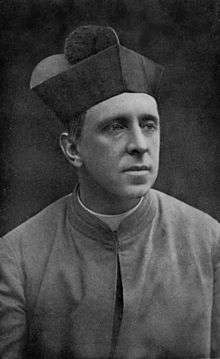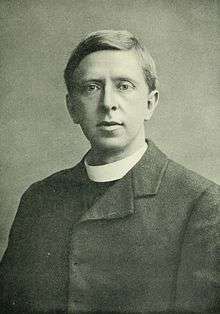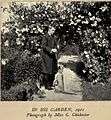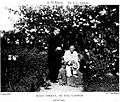Robert Hugh Benson
| Robert Hugh Benson | |
|---|---|
 Photo of Benson by G. Jerrard, 1912 | |
| Born |
Robert Hugh Benson 18 November 1871 Wellington College, Berkshire |
| Died |
19 October 1914 (aged 42) Bishop's house Salford Cathedral, Salford |
| Parent(s) | Edward White Benson and Mary Sidgwick Benson |
| Church | Roman Catholic |
| Ordained | 1904 |
Robert Hugh Benson AFSC KC*SG KGCHS (18 November 1871 – 19 October 1914) was an English Anglican priest who in 1903 was received into the Roman Catholic Church in which he was ordained priest in 1904. He wrote the notable novel Lord of the World (1907).
Life
Benson was the youngest son of Edward White Benson (Archbishop of Canterbury) and his wife, Mary, and the younger brother of Edward Frederic Benson and A. C. Benson.[1]
Benson was educated at Eton College and then studied classics and theology at Trinity College, Cambridge, from 1890 to 1893.[2]
In 1895, Benson was ordained a priest in the Church of England by his father, who was the then Archbishop of Canterbury.
After his father died suddenly in 1896, Benson was sent on a trip to the Middle East to recover his own health. While there he began to question the status of the Church of England and to consider the claims of the Roman Catholic Church. His own piety began to tend toward the High Church tradition, and he started exploring religious life in various Anglican communities, eventually obtaining permission to join the Community of the Resurrection.
Benson made his profession as a member of the community in 1901, at which time he had no thoughts of leaving the Church of England. As he continued his studies and began writing, however, he became more and more uneasy with his own doctrinal position and, on 11 September 1903, he was received into the Catholic Church. He was awarded the Dignitary of Honour of the Order of the Holy Sepulchre.
Benson was ordained as a Roman Catholic priest in 1904 and sent to Cambridge. He continued his writing career along with his ministry as a priest.
Like both his brothers, Edward Frederic Benson ("Fred") and Arthur Christopher Benson, Robert wrote many ghost and horror stories, collected in The Light Invisible (1903) and A Mirror of Shallott (1907).[1] His novel, Lord of the World (1907), is generally regarded as one of the first modern dystopias (see List of dystopian literature).[1]
As a young man, Benson recalled, he had rejected the idea of marriage as "quite inconceivable".[3] Benson was appointed a supernumerary private chamberlain to the Pope in 1911 and, consequently, styled as Monsignor.
Death and legacy
Benson died in 1914 in Salford, where he had been preaching a mission. He was 42. At his request, he was buried in the orchard of Hare Street House, his house in the Hertfordshire village of Hare Street.[4] A chapel, dedicated to St Hugh, was built over the site. Benson bequeathed the house to the Catholic Church as a county retreat for the Archbishop of Westminster. The Roman Catholic church in the nearby town of Buntingford, which he helped finance, is dedicated to St Richard of Chichester, but also known as the Benson Memorial Church.[5]
Gallery
 Colour Portrait of Robert Hugh Benson
Colour Portrait of Robert Hugh Benson Birthplace of Robert Hugh Benson. From the book "Hugh, Memoirs of a Brother"
Birthplace of Robert Hugh Benson. From the book "Hugh, Memoirs of a Brother" Robert Hugh Benson and Beth at the Chancery, Lincoln, in 1876, aged 5. From the book "Hugh, Memoirs of a Brother"
Robert Hugh Benson and Beth at the Chancery, Lincoln, in 1876, aged 5. From the book "Hugh, Memoirs of a Brother" Benson, age 5, by R. Slingsby, 1876
Benson, age 5, by R. Slingsby, 1876 A. C. Benson, R. H. Benson, and E. F. Benson, 1882. From the book "Hugh, Memoirs of a Brother"
A. C. Benson, R. H. Benson, and E. F. Benson, 1882. From the book "Hugh, Memoirs of a Brother" Robert Hugh Benson in 1889, aged 17. As Steerer in the St. George, at Eton. From the book "Hugh, Memoirs of a Brother"
Robert Hugh Benson in 1889, aged 17. As Steerer in the St. George, at Eton. From the book "Hugh, Memoirs of a Brother" Benson, age 17, by Hills & Saunders, 1889
Benson, age 17, by Hills & Saunders, 1889 Robert Hugh Benson in 1893, aged 21. As an undergraduate at Cambridge. From the book "Hugh, Memoirs of a Brother"
Robert Hugh Benson in 1893, aged 21. As an undergraduate at Cambridge. From the book "Hugh, Memoirs of a Brother" Benson, age 21, by Elliott & Fry, 1893
Benson, age 21, by Elliott & Fry, 1893 Robert Hugh Benson in 1906
Robert Hugh Benson in 1906 Robert Hugh Benson in 1907. From the book Memorials of Robert Hugh Benson
Robert Hugh Benson in 1907. From the book Memorials of Robert Hugh Benson Robert Hugh Benson in 1907, aged 35. From the book "Hugh, Memoirs of a Brother"
Robert Hugh Benson in 1907, aged 35. From the book "Hugh, Memoirs of a Brother" Benson, aged 35, by Russell & Sons, 1907
Benson, aged 35, by Russell & Sons, 1907 A. C. Benson, R. H. Benson, and E. F. Benson, 1907. From the book Memorials of Robert Hugh Benson
A. C. Benson, R. H. Benson, and E. F. Benson, 1907. From the book Memorials of Robert Hugh Benson Robert Hugh Benson at Hare Street House 1909. From the book Memorials of Robert Hugh Benson
Robert Hugh Benson at Hare Street House 1909. From the book Memorials of Robert Hugh Benson Robert Hugh Benson at Hare Street, 1909. From the book "Hugh, Memoirs of a Brother"
Robert Hugh Benson at Hare Street, 1909. From the book "Hugh, Memoirs of a Brother" Robert Hugh Benson in 1910, aged 39. From the book "Hugh, Memoirs of a Brother"
Robert Hugh Benson in 1910, aged 39. From the book "Hugh, Memoirs of a Brother" Robert Hugh Benson in His Garden 1911. From the book Memorials of Robert Hugh Benson
Robert Hugh Benson in His Garden 1911. From the book Memorials of Robert Hugh Benson Robert Hugh Benson at Hare Street, in the garden, 1911. From the book "Hugh, Memoirs of a Brother"
Robert Hugh Benson at Hare Street, in the garden, 1911. From the book "Hugh, Memoirs of a Brother" Benson, aged 40, by Sarony, 1912
Benson, aged 40, by Sarony, 1912 Robert Hugh Benson in 1912, aged 40. From the book "Hugh, Memoirs of a Brother"
Robert Hugh Benson in 1912, aged 40. From the book "Hugh, Memoirs of a Brother" Robert Hugh Benson in 1912 aged 40 in the Robes of a Papal Chamberlain. From the book "Hugh, Memoirs of a Brother"
Robert Hugh Benson in 1912 aged 40 in the Robes of a Papal Chamberlain. From the book "Hugh, Memoirs of a Brother" Benson, age 40
Benson, age 40 Robert Hugh Benson in 1913, aged 41. From the book "Hugh, Memoirs of a Brother"
Robert Hugh Benson in 1913, aged 41. From the book "Hugh, Memoirs of a Brother" The Calvary at Hare Street, 1913. From the book "Hugh, Memoirs of a Brother"
The Calvary at Hare Street, 1913. From the book "Hugh, Memoirs of a Brother" Benson, aged 41, 1913
Benson, aged 41, 1913 Robert Hugh Benson at Tremans, Horsted Keynes, December 1913. From the book "Hugh, Memoirs of a Brother"
Robert Hugh Benson at Tremans, Horsted Keynes, December 1913. From the book "Hugh, Memoirs of a Brother" Hare Street House from the Front and from the Garden, 1914. From the book "Hugh, Memoirs of a Brother"
Hare Street House from the Front and from the Garden, 1914. From the book "Hugh, Memoirs of a Brother" Bishop's House, Salford. From the book "Hugh, Memoirs of a Brother"
Bishop's House, Salford. From the book "Hugh, Memoirs of a Brother" Robert Hugh Benson's Hare Street House, Bunton. From the book Memorials of Robert Hugh Benson
Robert Hugh Benson's Hare Street House, Bunton. From the book Memorials of Robert Hugh Benson An Open Air Service at Buntingford Held by Robert Hugh Benson. From the book Memorials of Robert Hugh Benson
An Open Air Service at Buntingford Held by Robert Hugh Benson. From the book Memorials of Robert Hugh Benson H. E. Cardinal Bourne Gives the Last Blessing at the Funeral of Robert Hugh Benson. From the book Memorials of Robert Hugh Benson
H. E. Cardinal Bourne Gives the Last Blessing at the Funeral of Robert Hugh Benson. From the book Memorials of Robert Hugh Benson The Funeral of Robert Hugh Benson. From the book Memorials of Robert Hugh Benson
The Funeral of Robert Hugh Benson. From the book Memorials of Robert Hugh Benson Mrs. Benson. Mother of Robert Hugh Benson. From the book "Hugh, Memoirs of a Brother"
Mrs. Benson. Mother of Robert Hugh Benson. From the book "Hugh, Memoirs of a Brother"
Works
Science fiction
- A Mirror of Shalott, Benziger Brothers, 1907.
- Lord of the World, Dodd, Mead & Company, 1908 [1st Pub. 1907].
- The Dawn of All, B. Herder, 1911.[6]
Historical fiction
- By What Authority?, Isbister, 1904.
- Come Rack! Come Rope!, Dodd, Mead & Co., 1913 [1st Pub. 1912].
- Oddsfish!, Dodd, Mead & Co., 1914.
- The King's Achievement, Burns Oates & Washbourne, Lrd., 1905.
- The Queen's Tragedy, Sir Isaac Pitman & Sons Ltd., 1907.
- The History of Richard Raynal, Solitary, Sir Isaac Pitman & Sons Ltd., 1912.
- Initiation, Dodd, Mead & Co., 1914.[7]
Contemporary Fiction
- The Light Invisible, Sir Isaac Pitman and Sons Ltd., 1906.
- The Sentimentalists, Sir Isaac Pitman and Sons Ltd., 1906.
- The Conventionalists, Hutchinson & Co., 1908.
- The Necromancers, Hutchinson & Co., 1909.
- The Winnowing, B. Herder, 1910.
- None other gods, B. Herder, 1911.
- The Coward, B. Herder, 1912.
- An Average Man, Dodd, Mead & Company, 1913.
- Loneliness?, Dodd, Mead & Co., 1915.
Children's Books
- Alphabet of Saints, with Reginald Balfour and Charles Ritchie, illustraded by L. D. Symington, Oates & Washbourne, 1905.
- A Child's Rule of Life, illustrated by Gabriel Pippet, digitized by Richard Mammana.
- Old Testament Rhymes, illustrated by Gabriel Pippet.
Devotional Works
- Vexilla Regis: A Book of Devotions and Intercessions, Longmans, Green & Co., 1915 [1st Pub. 1914].
- A Book of the Love of Jesus: A Collection of Ancient English Devotions in Prose and Verse, Isaac Pitman & Sons, 1915.
- The Friendship of Christ, Longmans, Green & Co., 1914 [1st Pub. 1912].
Apologetic Works
- The Religion of the Plain Man, Burns & Oates, 1906.
- Papers of a Pariah, Longmans, Green & Co., 1907.
- Christ in the Church: A Volume of Religious Essays, Longmans, Green & Co., 1911.
- Confessions of a Convert, Longmans, Green & Co., 1913.
- Paradoxes of Catholicism, Longmans, Green & Co., 1913.
- Lourdes, The Manresa Press, 1914.
- Spiritual Letters of Monsignor R. Hugh Benson: to One of his Converts, Longmans, Green & Co., 1915.
- A Book of Essays, Catholic Truth Society, 1916.
- Sermon Notes, First Series: Anglican, Second Series: Catholic, Longmans, Green & Co., 1917.
- Non-Catholic Denominations, Longmans, Green & Co., 1921.
Plays
- The Cost of a Crown, a Story of Douay & Durham; a Sacred Drama in Three Acts, Longmans, Green & Co., 1910.
- A Mystery Play in Honour of the Nativity of Our Lord, Longmans, Green, and Co., 1908.
- The Maid of Orleans, a Drama of the Life of Joan of Arc, Longmans, Green & Co., 1911.
- The Upper Room, a Drama of Christ's Passion, Longmans, Green & Co., 1914.
Selected articles
- "The Conversion of England," The American Ecclesiastical Review, Vol. XXXIV, 1906.
- "The State of Religion in England," The Catholic World, Vol. LXXXIV, October 1906/March 1907.
- "A Modern Theory of Human Personality," The Dublin Review, Vol. CXLI, 1907.
- "The Dissolution of the Religious Houses." In: Renascence and Reformation (From The Cambridge History of English Literature, 15 Vols.), 1908.
- "Letters of Queen Victoria, 1837-1861," The Dublin Review, Vol. CXLII, January/April 1908.
- "Christian Science," The Dublin Review, Vol. CXLIII, No. 286, October 1908.
- "Spiritualism," The Dublin Review, Vol. CXLV, No. 290-291, July/October, 1909.
- "A Catholic Colony," The Dublin Review, Vol. CXLVI, January/April, 1910.
- "Catholicism and the Future," The Atlantic Monthly, Vol. CVI, 1910.
- "Phantasms of the Dead," The Dublin Review, Vol. CL, No. 300-301, January/April, 1912.
- "Cosmopolitanism and Catholicism," The North American Review, September 1912.
- "Cardinal Gasquet," The Dublin Review, Vol. CLV, July/October, 1914.
Other
- The Holy Blissful Martyr Saint Thomas of Canterbury, Benziger Brothers, 1910.
- The Life of Saint Teresa, Herbert & Daniel, 1912.
- Poems, Burns & Oates, 1915.
- Maxims from the Writings of Mgr. Benson, By the compiler of "Thoughts from Augustine Birrell," R. & T. Washbourne Ltd., 1915.
Notes
- 1 2 3 Ashley, Mike (May–June 1984). "The Essential Writers: Blood Brothers (Profile of E.F., A.C. and R. H. Benson)". Rod Serling's The Twilight Zone Magazine. pp. 63–70.
- ↑ "Benson, Robert Hugh (BN890RH)". A Cambridge Alumni Database. University of Cambridge.
- ↑ Benson, Robert Hugh (1913). Confessions of a Convert. Longmans, Green and Co.
- ↑ Benson, A.C. Hugh: Memoirs of a Brother. Dodo Press. p. 210. ISBN 1406548197.
- ↑ http://taking-stock.org.uk/Home/Dioceses/Archdiocese-of-Westminster/St-Richard-of-Chichester-Buntingford
- ↑ "The Dawn of All," The Bookman, September 1911.
- ↑ Cooper, Frederick Taber. "The Accustomed Manner and Some Recent Novels," The Bookman, May 1914.
References
- Beesley, Thomas Quinn (1916). "The Poetry of Robert Hugh Benson," The Catholic Educational Review, Vol. XII, pp. 122–134.
- Benson, Arthur C. (1915). Hugh: Memoir of a Brother. London: Smith, Elder & Co.
- Bleiler, Everett (1948). The Checklist of Fantastic Literature. Chicago: Shasta Publishers.
- Bour'his, Jean Morris le (1980). Robert Hugh Benson, Homme de Foi et Artiste. Atelier Reproduction de Thèses, Université de Lille III.
- Braybrooke, Patrick (1931). "Robert Hugh Benson; Novelist and Philosopher." In: Some Catholic Novelists. London: Burns, Oates & Washbourne.
- Brown, Stephen J.M. & Thomas McDermott (1945). A Survey of Catholic Literature. Milwaukee: The Bruce Publishing Company.
- Concannon, Helena (1914). "Robert Hugh Benson, Novelist," Part II, The Catholic World, Vol. XCIX, pp. 487–498, 635–645.
- Gorce, Agnès de La (1928). Robert Hugh Benson: Prêtre et Romancier, 1871-1914. Paris: Plon.
- Grayson, Janet (1998). Robert Hugh Benson: Life and Works. Lanham, Md.: University Press of America.
- Watt, Reginald J.J. (1918). Robert Hugh Benson: Captain in God's Army. London: Burns & Oates Ldt.
- Warre Cornish, Blanche (1914). Memorials of Robert Hugh Benson. New York: P.J. Kenedy & Sons.
- McMahon, Joseph H. (1915). "The Late Monsignor Robert Hugh Benson," Records of the American Catholic Historical Society of Philadelphia, Vol. XXVI, pp. 55–63.
- McMahon, Joseph H. (1915). "Robert Hugh Benson: A Personal Memory," The Bookman, Vol. XLI, pp. 160–169.
- Monaghan, Sister Mary Saint Rita (1985). Monsignor Robert Hugh Benson: His Apostolate and Its Message for Our Time. Brisbane, Qld.: Boolarong Publications.
- Martindale, C.C. (1916). The Life of Monsignor Robert Hugh Benson, Vol. 2. London: Longmans, Green & Co.
- Ross, Allan (1915). Monsignor Hugh Benson (1871-1914). The Catholic Truth Society.
- Parr, Olive Katherine (1915). Robert Hugh Benson: An Appreciation. London: Hutchinson & Co.
- Shuster, Norman (1922). "Robert Hugh Benson and the Aging Novel." In: The Catholic Spirit in Modern English Literature. New York: The Macmillan Company, pp. 208–228.
External links
| Wikimedia Commons has media related to Robert Hugh Benson. |
- Biographical Portrait of Msgr. Benson
- Works by Robert Hugh Benson at Project Gutenberg
- Works by or about Robert Hugh Benson at Internet Archive
- Works by Robert Hugh Benson at LibriVox (public domain audiobooks)

- R. H. Benson at the Internet Speculative Fiction Database
- Spanish Web Site on Robert Hugh Benson
- R. H. Benson at AuthorWars.com
- Catholic Authors: R. H. Benson
- Biography Hugh: Memoirs of a Brother by Arthur Christopher Benson
- Robert Hugh Benson at Library of Congress Authorities, with 63 catalogue records